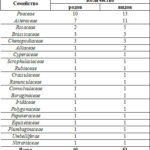Merkusheva M.G., Badmaeva N.K., Boloneva L.N., Lavrentieva I.N. LEYMUS CHINENSIS (Trin.) Tzvelev) IN THE WESTERN TRANSBAIKALIA: STRUCTURE OF COMMUNITIES, PRODUCTS AND BIOCHEMICAL COMPOSITION DURING CLIMATE ARIDIZATION // Arid ecosystems. 2021. V. 27. № 1 (86). P. 86-96. | PDF
The phytocenotic characterization of communities with Leymus chinensis growing on different types of soils of the meadow steppe, steppe floodplain, and halophytic meadows of Western Transbaikalia is considered. The botanical composition revealed glycophytes – 28 species, halotolerant glycophytes– 17 and halophytes – 6. It was established that the genus Leymus includes 3 species: Leymus chinensis, L. buriaticus, L. littoralis. The botanical composition of communities with Leymus chinensis of Western Transbaikalia is represented by 51 species, 20 families, and 40 genera. The species composition is represented mainly by the steppe complex with different xerophytic species belonging to the Asian type of range. In the biomorph, the main share falls on rhizome species, and the proportion of young infants is also significant. The similarity between the species composition is in the interval “weak – average”, which is due to the significant participation of families and genera with low species richness. The primary production communities with Leymus chinensis is 1029–2370 g/m2×year; the aboveground phytomass almost completely forms Leymus chinensis. The biochemical composition, feed value and protein ratio of the edible dry matter are determined by the growing conditions, but on the whole they comply with standard indicators.
Keywords: Leymus chinensis, communities, species diversity, production, biochemical composition, feed value, Western Transbaikalia, climate aridization.
DOI: 10.24411/1993-3916-2021-10140


